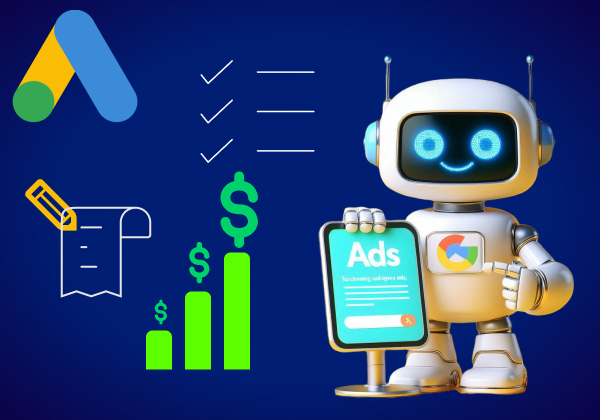How to write effective ads in Google ADS

- Introduction: Why it’s important to have quality ads
- Principles for creating attention-grabbing ads
- How the headline works
- Using emotions and numbers
- How to highlight your unique value proposition (USP)
- Why is your offer better?
- Examples of successful USPs
- Using calls to action (CTAs)
- How CTAs compel users to take action
- How to test CTAs for greater effectiveness
- Testing ad variations (A/B testing)
- What is A/B testing and how to implement it
- What to test in Google Ads
- Conclusions: How to turn words into conversions
Google Ads is a powerful tool that can help businesses reach their audience, attract customers, and increase revenue. But how well your ads perform depends on their copy and structure. In this guide, we’ll cover the key principles of writing effective ads, focusing on unique value propositions and calls to action, and the importance of testing different variations.
1. Introduction: Why it’s important to have quality ads
Your ad copy is the first thing a potential customer sees. It’s your chance to make an impression in just a few seconds and convince them to click on your ad.
“Google Ads is more than just text. It’s your key to a conversation with your customer.”
An effective ad has:
- Attract attention by using a relevant headline.
- Engage the user by highlighting the benefits of your product or service.
- Encourage action through a call to action.
“Why is the text so important?”
The text of the ad is your first contact with a potential customer. People make decisions in a split second, guided by just a few words. At the same time, it is important not only to attract attention, but also to keep it, to arouse interest in your offer. For example, an ad that promises “Free shipping” or “50% discount” works more effectively than abstract phrases.
Additionally, quality copy affects the Quality Score that Google uses to rank your ads. The higher the score, the cheaper the clicks will be and the more often your ad will be shown to your audience.
2. Principles for creating attention-grabbing ads
2.1. How the headline works
“A good headline can do all the work for you.” It’s the first thing a user sees, so it needs to be as interesting and relevant as possible. Include keywords that match the user’s query. For example, if you sell sneakers, a headline like “Buy Running Shoes for 20% Off” works better than just “Sneakers on Sale.”
The headline should contain the keywords that the user enters in the search. For example, if the user searches for “buy a cheap smartphone”, your ad should include these exact words. This increases the relevance of the ad and the likelihood that it will be noticed.
Additionally, avoid clichés like “Best Deals.” Instead, focus on something specific, like “This week only: smartphones up to 30% off.”
2.2. Using emotions and numbers
People respond to numbers because they are concrete. Compare these two headlines:
- “Buy the best smartphones.”
- “Buy smartphones from $199 with a 2-year warranty.”
The second option is much more convincing. You can also add an emotional subtext, such as “Feel the freedom with your new smartphone!”
Numbers give concreteness to ads. For example:
- Instead of “Fast delivery”, write “Delivery in 24 hours”.
- Instead of “Large selection of products,” use “Over 10,000 products in stock.”
Emotions also trigger associations that help drive decisions. For example, an ad with the text “Give your family the gift of warmth: buy a heater with a 20% discount” creates warm images, not just dry facts.
3. How to highlight your unique value proposition (USP)
3.1. Why is your offer better?
“The uniqueness of the offer is what makes the user choose you over the competitor.” Your unique value proposition (USP) should answer the question: Why should I choose this?
State what makes your product or service better:
- Exclusive features.
- Discounts or special offers.
- Reviews of satisfied customers.
For example:
- “Book a hotel for free: pay only for your stay!”
- “The fastest internet in your area — guaranteed!”
A USP should not only show your benefits, but also solve a specific problem for the customer. For example:
- You sell athletic shoes. Your USP is: “Running shoes that reduce pressure on your knees by 40%.”
- You offer consulting services. Your USP is: “We help small businesses increase profits by 20% in three months.”
The key is to offer something unique that sets you apart from your competitors.
3.2. Examples of successful USPs
- “Free delivery within 24 hours — no hidden conditions.”
- “Build your own computer and get 10% off.”
- “Your favorite drink made with 100% natural ingredients.”
Examples can be taken from real life:
- “Buy coffee that helps preserve nature: 1% of every purchase goes to protect forests.”
- “Textbooks for students that are always available, even during sessions.”
Such USPs demonstrate concern for customers or their needs, which significantly increases trust.
4. Using calls to action (CTAs)
4.1. How CTAs compel users to take action
“A call to action is what pushes the customer to take the next step.” It’s important to keep your CTA specific and clear. Instead of a generic “Learn more,” try “Get a free consultation today!”
CTAs work better if they:
- Offer a specific benefit (e.g., “Download a free guide”).
- They use verbs that encourage action: “Buy”, “Order”, “Subscribe”.
Research shows that people are more likely to respond to specific, rather than vague, appeals. For example:
- Instead of “Buy Now,” try “Buy Today and Get a Gift.”
- Instead of “Sign up” use “Sign up and get 10% off your first purchase.”
CTAs also work better if they create a sense of urgency:
- “The offer is valid until the end of the week.”
- “Only 5 left in stock.”
4.2. How to test CTAs for greater effectiveness
Use Google Ads to test different versions of your CTA. For example, use “Order today” for the first version and “Learn about a special offer” for the second. Analyze which version drives more clicks or conversions.
Don’t be afraid to experiment with different variations. For example, try changing the phrasing, the color of the button, or even the order of the words. When testing, pay attention to the conversion rate – it will show which CTA works best.
5. Testing Ad Variants (A/B Testing)
5.1. What is A/B testing and how to implement it
A/B testing is the process of creating two or more versions of your ads to see which one performs best. For example, you can change the headline, CTA, or even the display URL.
“Testing allows you to discover what exactly influences a user’s decision to click.”
Run tests in Google Ads and collect data on clicks, CTR, and conversions for each variation. Keep only the ad that performs best.
A/B testing can be done at several levels: headlines, descriptions, links, CTA. For example, for one advertising campaign, create two ad variants:
- “Order the best sneakers online”
- “Running shoes with a 20% discount — order today”
After a certain period of time, evaluate them based on parameters such as CTR (Click-Through Rate) and conversions.
5.2. What to test in Google Ads
- Headings: short or detailed, with or without numbers.
- Description: A more formal or emotional style.
- CTA: different call-to-action options.
- Display URL: Short or long URLs that include keywords.
In addition to headlines and CTAs, test different ad extensions (e.g., links to subpages, contact information, testimonials). Sometimes even small changes, like adding the word “discount,” can make a big difference in ad performance.
6. Conclusions: How to turn words into conversions
Google Ads copy is your 24/7 tool. Use every word to grab attention, highlight your offer, and inspire action. Remember, success isn’t just about how great your ad sounds, it’s also about how well it resonates with your audience.
“Advertising is not just about sales, it’s also about building trust.”
So experiment, improve, and analyze your data. Your ideal customers are already waiting for the right ad!
Remember that ad copy is only one part of your strategy. Once you’ve launched your campaign, it’s important to constantly analyze its effectiveness, identify weaknesses, and refine your copy. And remember: success comes to those who experiment and take into account the needs of their audience.



